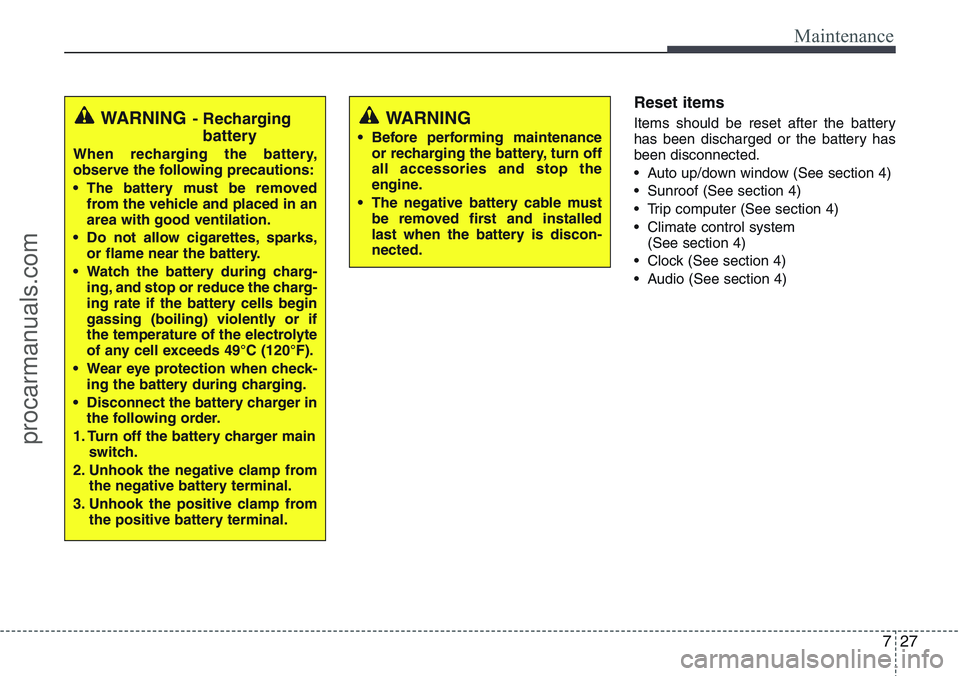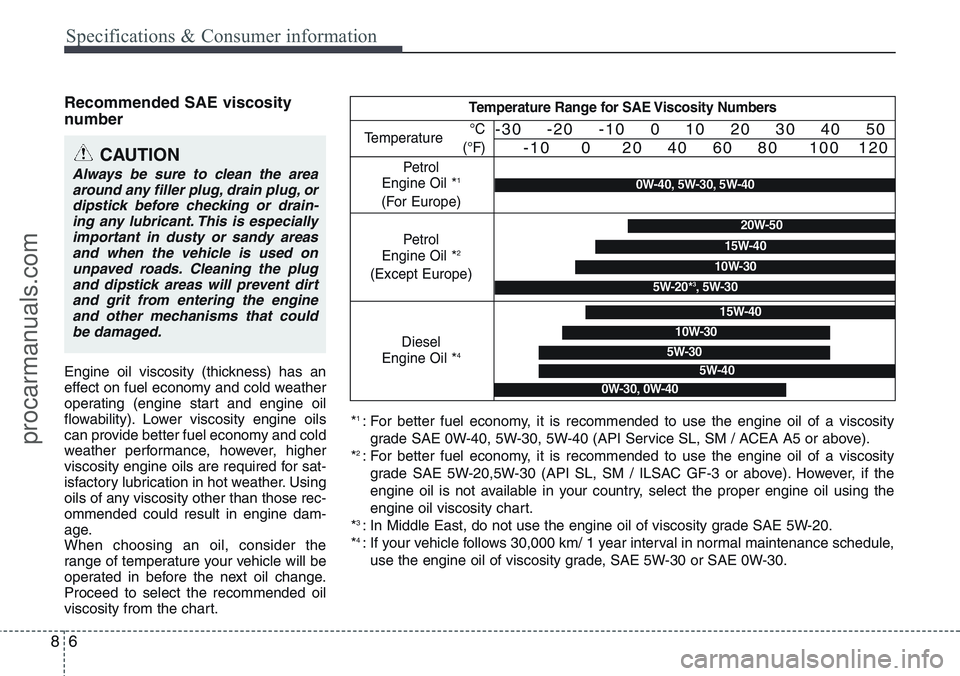Page 329 of 385
Maintenance
18 7
✽NOTICE
New automatic transaxle fluid should be
red. The red dye is added so the assem-
bly plant can identify it as automatic
transaxle fluid and distinguish it from
engine oil or antifreeze. The red dye,
which is not an indicator of fluid quali-
ty, is not permanent. As the vehicle is
driven, the automatic transaxle fluid
will begin to look darker. The colour
may eventually appear light brown.
Therefore, have a HYUNDAI autho-
rised repairer change the automatic
transaxle fluid according to the
Scheduled Maintenance.
Use only specified automatic transaxle
fluid. (Refer to "Recommended lubricants
or capacities" in section 8.)
Changing the automatic transaxle
fluid
Have the automatic transaxle fluid
changed by a HYUNDAI authorised
repairer according to the Maintenance
Schedule.
procarmanuals.com
Page 338 of 385

727
Maintenance
Reset items
Items should be reset after the battery
has been discharged or the battery has
been disconnected.
• Auto up/down window (See section 4)
• Sunroof (See section 4)
• Trip computer (See section 4)
• Climate control system
(See section 4)
• Clock (See section 4)
• Audio (See section 4)WARNING
• Before performing maintenance
or recharging the battery, turn off
all accessories and stop the
engine.
• The negative battery cable must
be removed first and installed
last when the battery is discon-
nected.
WARNING- Recharging
battery
When recharging the battery,
observe the following precautions:
• The battery must be removed
from the vehicle and placed in an
area with good ventilation.
• Do not allow cigarettes, sparks,
or flame near the battery.
• Watch the battery during charg-
ing, and stop or reduce the charg-
ing rate if the battery cells begin
gassing (boiling) violently or if
the temperature of the electrolyte
of any cell exceeds 49°C (120°F).
• Wear eye protection when check-
ing the battery during charging.
• Disconnect the battery charger in
the following order.
1. Turn off the battery charger main
switch.
2. Unhook the negative clamp from
the negative battery terminal.
3. Unhook the positive clamp from
the positive battery terminal.
procarmanuals.com
Page 355 of 385
Maintenance
44 7
DescriptionFuse ratingSystemProtected Component
15ATRANSMISSION
CONTROL UNITSpeed In Sensor, Speed Out Sensor, Speed Sensor, Inhibitor Switch
10AIGNITION COILIgnition Coil, Condensor
10AIGNITIONHLLD Switch, HLLD Actuator, BCM, Air Conditioning System, Sunroof,
ETCS
25AWINDSCREEN WIPING
SYSTEM (CONTINUOUS)Front Wiper Moter Relay, Multi Function Switch Wiper
10AFRONT FOG LAMPFront Fog Lamp, BCM
10AREAR FOG LAMPRear Fog Lamp, BCM
10AROOM LAMPRoom Lamp Switch, MUT
15ASTOP LAMPStop Switch, BCM
10ACLUSETERCluster, BCM, Digtal Clock
10AIGNITIONAudio,TPMS, IMMOUNIT, Centre Facia Switch
10AANTI-LOCK BRAKE SYSTEMYaw Rate Sensor, ABS(ESP),ESP Switch
10AB/UP LPBack Up Switch
10AELECTRONIC (ENGINE)
CONTROL UNITECU, AFS
10ARAIN SENSOR
(PTC HEATER )Rain Sensor Relay (PTC, Fuel Filter Heater)
10APOWER DISTRIBUTION
MODULESmart key Uint
procarmanuals.com
Page 381 of 385

Specifications & Consumer information
4 8
RECOMMENDED LUBRICANTS AND CAPACITIES
To help achieve proper engine and powertrain performance and durability, use only lubricants of the proper quality. The correct
lubricants also help promote engine efficiency that results in improved fuel economy.
These lubricants and fluids are recommended for use in your vehicle.
Lubricant Volume Classification
Engine oil *
1*2
(drain and refill)
Petrol Engine3.3l (2.9 Imp. qts.)For Europe
API Service SL or SM, ACEA A5 or above
Use the engine oils approved by Hyundai Motor Company.
Consult a HYUNDAI authorised repairer for details.
Except Europe
API Service SM *
3,
ILSAC GF-4 or above
Diesel Engine5.3l (4.66 Imp. qts.)With DPF (Diesel Particulate filter) : ACEA C3
Without DPF (Diesel Particulate filter) : ACEA B4, API CH-4 or
above
Engine oil
consumptionNormal driving conditionMAX. 1l /1000 miles (1500 km)
Severe driving conditionMAX. 1l /620 miles (1000 km)
Manual
transaxle fluidPetrol
Engine1.4 L1.9l (1.67 Imp. qts.)
API GL-4 SAE 75W-85
(fill for-life)
1.6 L1.8l (1.58 Imp. qts.)
Diesel Engine 1.9l (1.67 Imp. qts.)
Automatic transaxle fluid6.8l (5.98 Imp. qts.)
DIAMOND ATF SP-III, SK ATF SP-III
procarmanuals.com
Page 382 of 385
85
Specifications & Consumer information
*1: Refer to the recommended SAE viscosity numbers on the next page.
*2: Engine oils labeled Energy Conserving Oil are now available. Along with other additional benefits, they contribute to fuel econ-
omy by reducing the amount of fuel necessary to overcome engine friction. Often, these improvements are difficult to measure
in everyday driving, but in a year’s time, they can offer significant cost and energy savings.
*
3: If the API service SM engine oil is not available in your country, you are able to use API service SL.Lubricant Volume Classification
CoolantPetrol Engine5.8 ~ 5.9 l
(5.10~5.19 Imp. qts.)
Ethylene glycol base coolant for aluminum radiator
Diesel Engine6.3l (5.54 Imp. qts.)
Brake/Clutch fluid0.7~0.8l
(0.62~0.7 Imp. qts.)FMVSS116 DOT-3 or DOT-4
Fuel48l (10.56 Imp. gal.)-
procarmanuals.com
Page 383 of 385

Specifications & Consumer information
6 8
Recommended SAE viscosity
number
Engine oil viscosity (thickness) has an
effect on fuel economy and cold weather
operating (engine start and engine oil
flowability). Lower viscosity engine oils
can provide better fuel economy and cold
weather performance, however, higher
viscosity engine oils are required for sat-
isfactory lubrication in hot weather. Using
oils of any viscosity other than those rec-
ommended could result in engine dam-
age.
When choosing an oil, consider the
range of temperature your vehicle will be
operated in before the next oil change.
Proceed to select the recommended oil
viscosity from the chart.
CAUTION
Always be sure to clean the area
around any filler plug, drain plug, or
dipstick before checking or drain-
ing any lubricant. This is especially
important in dusty or sandy areas
and when the vehicle is used on
unpaved roads. Cleaning the plug
and dipstick areas will prevent dirt
and grit from entering the engine
and other mechanisms that could
be damaged.
Temperature Range for SAE Viscosity Numbers
Temperature
Petrol
Engine Oil *
1
(For Europe)°C
(°F)
-30 -20 -10 0 10 20 30 40 50
-10 0 20 40 60 80 100 120
Diesel
Engine Oil *45W-30
15W-40
10W-30
0W-40, 5W-30, 5W-40
Petrol
Engine Oil *2
(Except Europe)
20W-50
10W-30
15W-40
5W-20*3, 5W-30
*1 : For better fuel economy, it is recommended to use the engine oil of a viscosity
grade SAE 0W-40, 5W-30, 5W-40 (API Service SL, SM / ACEA A5 or above).
*
2 : For better fuel economy, it is recommended to use the engine oil of a viscosity
grade SAE 5W-20,5W-30 (API SL, SM / ILSAC GF-3 or above). However, if the
engine oil is not available in your country, select the proper engine oil using the
engine oil viscosity chart.
*
3 : In Middle East, do not use the engine oil of viscosity grade SAE 5W-20.
*4 : If your vehicle follows 30,000 km/ 1 year interval in normal maintenance schedule,
use the engine oil of viscosity grade, SAE 5W-30 or SAE 0W-30.
5W-40
0W-30, 0W-40
procarmanuals.com
Page:
< prev 1-8 9-16 17-24